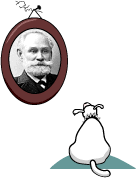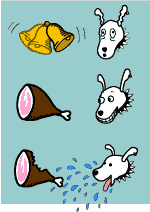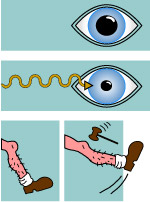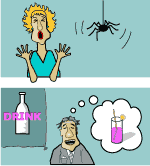Ivan Petrovich Pavlov and conditioned reflexes
Who was Ivan Pavlov (1849-1936)?
 The Russian scientist Ivan
Petrovich Pavlov was born in 1849 in Ryazan, where
his father worked as a village priest. In 1870 Ivan
Pavlov abandoned the religious career for which he
had been preparing, and instead went into science.
There he had a great impact on the field of
physiology by studying the mechanisms underlying the
digestive system in mammals.
The Russian scientist Ivan
Petrovich Pavlov was born in 1849 in Ryazan, where
his father worked as a village priest. In 1870 Ivan
Pavlov abandoned the religious career for which he
had been preparing, and instead went into science.
There he had a great impact on the field of
physiology by studying the mechanisms underlying the
digestive system in mammals.
For his original work in this field of research, Pavlov was awarded the Nobel Prize in Physiology or Medicine in 1904. By then he had turned to studying the laws on the formation of conditioned reflexes, a topic on which he worked until his death in 1936. His discoveries in this field paved the way for an objective science of behavior.
Pavlov's drooling dogs
 While Ivan Pavlov worked to
unveil the secrets of the digestive system, he also
studied what signals triggered related phenomena,
such as the secretion of saliva. When a dog
encounters food, saliva starts to pour from the
salivary glands located in the back of its oral
cavity. This saliva is needed in order to make the
food easier to swallow. The fluid also contains
enzymes that break down certain compounds in the
food. In humans, for example, saliva contains the
enzyme amylase, an effective processor of starch.
While Ivan Pavlov worked to
unveil the secrets of the digestive system, he also
studied what signals triggered related phenomena,
such as the secretion of saliva. When a dog
encounters food, saliva starts to pour from the
salivary glands located in the back of its oral
cavity. This saliva is needed in order to make the
food easier to swallow. The fluid also contains
enzymes that break down certain compounds in the
food. In humans, for example, saliva contains the
enzyme amylase, an effective processor of starch.
Pavlov became interested in studying reflexes when he saw that the dogs drooled without the proper stimulus. Although no food was in sight, their saliva still dribbled. It turned out that the dogs were reacting to lab coats. Every time the dogs were served food, the person who served the food was wearing a lab coat. Therefore, the dogs reacted as if food was on its way whenever they saw a lab coat.
In a series of experiments, Pavlov then tried to figure out how these phenomena were linked. For example, he struck a bell when the dogs were fed. If the bell was sounded in close association with their meal, the dogs learnt to associate the sound of the bell with food. After a while, at the mere sound of the bell, they responded by drooling.
Different kinds of reflexes
 Reflexes make us react in a
certain way. When a light beam hits our eyes, our
pupils shrink in response to the light stimulus. And
when the doctor taps you below the knee cap, your leg
swings out. These reflexes are called unconditioned,
or built-in. The body responds in the same fashion
every time the stimuli (the light or the tap) is
applied. In the same way, dogs drool when they
encounter food.
Reflexes make us react in a
certain way. When a light beam hits our eyes, our
pupils shrink in response to the light stimulus. And
when the doctor taps you below the knee cap, your leg
swings out. These reflexes are called unconditioned,
or built-in. The body responds in the same fashion
every time the stimuli (the light or the tap) is
applied. In the same way, dogs drool when they
encounter food.
Pavlov's discovery was that environmental events that previously had no relation to a given reflex (such as a bell sound) could, through experience, trigger a reflex (salivation). This kind of learnt response is called conditioned reflex, and the process whereby dogs or humans learn to connect a stimulus to a reflex is called conditioning.
Animals generally learn to associate stimuli that are relevant to their survival. Food aversion is an example of a natural conditioned reflex. If an animal eats something with a distinctive vanilla taste and then eats a tasteless poison that leads to nausea, the animal will not be particularly eager to eat vanilla-flavoured food the next time. Linking nausea to taste is an evolutionarily successful strategy, since animals that failed to learn their lesson did not last very long.
Why were Pavlov's findings given so much acknowledgment?
Pavlov's description on how animals (and humans) can be trained to respond in a certain way to a particular stimulus drew tremendous interest from the time he first presented his results. His work paved the way for a new, more objective method of studying behavior.
So-called Pavlovian training has been used in many fields, with anti-phobia treatment as but one example. An important principle in conditioned learning is that an established conditioned response (salivating in the case of the dogs) decreases in intensity if the conditioned stimulus (bell) is repeatedly presented without the unconditioned stimulus (food). This process is called extinction.
 In order to treat phobias
evoked by certain environmental situations, such as
heights or crowds, this phenomenon can be used. The
patient is first taught a muscle relaxation
technique. Then he or she is told , over a period of
days, to imagine the fear-producing situation while
trying to inhibit the anxiety by relaxation. At the
end of the series, the strongest anxiety-provoking
situation may be brought to mind without anxiety.
This process is called systematic
desensitization.
In order to treat phobias
evoked by certain environmental situations, such as
heights or crowds, this phenomenon can be used. The
patient is first taught a muscle relaxation
technique. Then he or she is told , over a period of
days, to imagine the fear-producing situation while
trying to inhibit the anxiety by relaxation. At the
end of the series, the strongest anxiety-provoking
situation may be brought to mind without anxiety.
This process is called systematic
desensitization.
Conditioning forms the basis of much of learned human behavior. Nowadays, this knowledge has also been exploited by commercial advertising. An effective commercial should be able to manipulate the response to a stimulus (like seeing a product's name) which initially does not provoke any feeling. The objective is to train people to make the "false" connection between positive emotions (e.g. happiness or feeling attractive) and the particular brand of consumer goods being advertised.
Pavlov's prize
 Although the first image that
comes to mind while mentioning Ivan Pavlov's name is
his drooling dogs, he became a Nobel Laureate for his
research in a different field. In 1904 he received
the Nobel Prize in Physiology or Medicine for his
pioneering studies of how the digestive system
works.
Although the first image that
comes to mind while mentioning Ivan Pavlov's name is
his drooling dogs, he became a Nobel Laureate for his
research in a different field. In 1904 he received
the Nobel Prize in Physiology or Medicine for his
pioneering studies of how the digestive system
works.
Until Pavlov started to scrutinize this field, our knowledge of how food was digested in the stomach, and what mechanisms were responsible for regulating this, were quite foggy.
In order to understand the process, Pavlov developed a new way of monitoring what was happening. He surgically made fistulas in animals' stomachs, which enabled him to study the organs and take samples of body fluids from them while they continued to function normally.
By Lotta Fredholm, Science Journalist
More about Nobel Laureate Ivan Pavlov
First published 15 May 2001
MLA style: "Pavlov's Dog". Nobelprize.org. Nobel Prize Outreach AB 2022. <http://nobel-external-educationalgames-app.azurewebsites.net/educational/medicine/pavlov/readmore.php>